These fermented dill pickles are so easy. Simply pack them in a jar and they will last in a dark, cool location for up to a year! No canning, scum removal, or repackaging required!
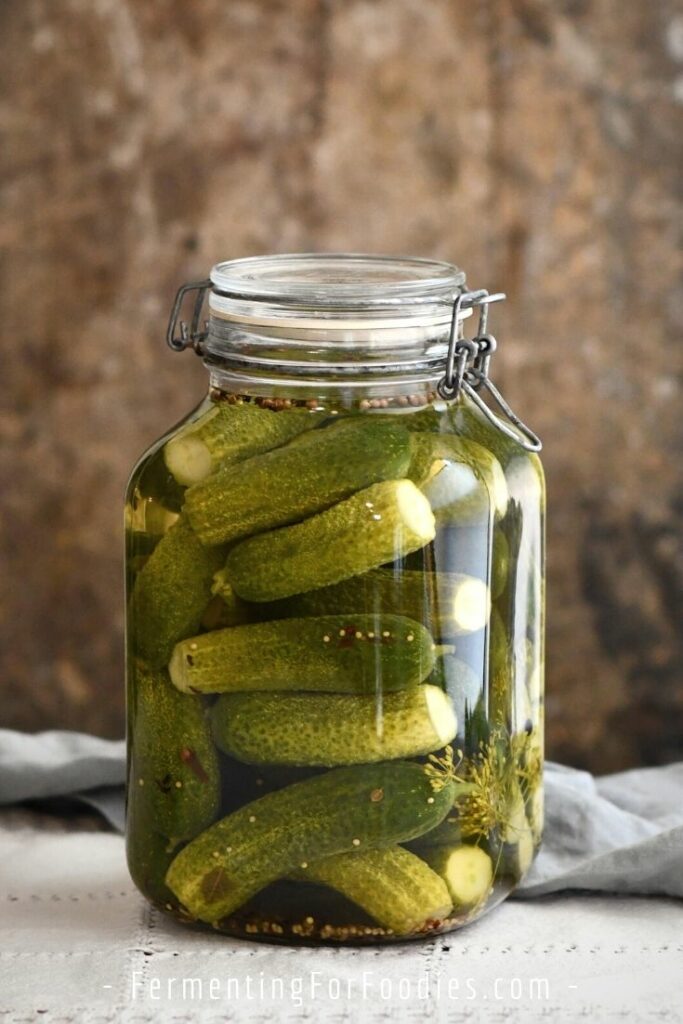
These fermented dill pickles are my absolute favorite. The recipe comes from a hand-me-down canning cookbook from the 1950s. It is well-used and tape now holds most of the pages together, but it still has some inspiring recipes.
The reason this is my favorite recipe is that it is so SIMPLE. All you have to do is pack the cucumbers into a canning jar with the brine and cap it with a lid. No skimming is required. You don’t have to check on them. They’ll last for up to a year in a cool dark location without any further preservation.
I’ve been making them for years… and never had an issue.
An offbeat fermented dill pickle recipe
This recipe is very different from the usual Lacto-fermented pickles. There’s no scum removal, canning, or preserving. And it makes the most delicious traditional Eastern European style pickle.
I usually turn about 10 lbs. of cucumbers into pickles every year. They get packed into jars in early September and we usually finish eating them by May. I’ve never had a failure with this recipe. However, if you’re uncertain, just make a few smaller batches and start eating them after one month of fermenting.
Tips and Tricks
It can be a bit daunting the first time you make fermented vegetables. However, it is a perfectly safe and delicious way to preserve food. Best of all there’s no canning required with this low-energy, zero-waste recipe.
Here are a few tips to make sure your pickles are a success:
- Start with sanitized jars. Either run them through the dishwasher on a sani-cycle or pour boiling water over the jars and the lids. I don’t do this for short ferments… but it is recommended if you want to pack your pickles away for winter eating.
- Don’t use any cucumbers with mold or slime.
- This is a garlic-free recipe because garlic can introduce unwanted strains of bacteria.
- The best cucumbers are farm-fresh. They’ll be firm and have plenty of natural Lacto-bacteria on their skin.
- Cool and dark is the best place to store these pickles. However, there are options for urbanites (like me) without garages or basements. Here’s a post all about storing fermented foods.
What type of jar should you use?
There are a number of different jars that can be used for fermented dill pickles.
- The traditional recipe calls for a standard mason jar with a metal lid and jar ring. With the lid screwed on finger-tight (not sealed), the gasses will still be able to escape. I usually do a few jars this way for eating within the first few months.
- I use 2-quart fido jars for pickles that are going to ferment for longer than a month. They are great for preventing contamination. (See photo at the top of the post).
- You could also use a mason jar with an airlock or a pickle pipe.
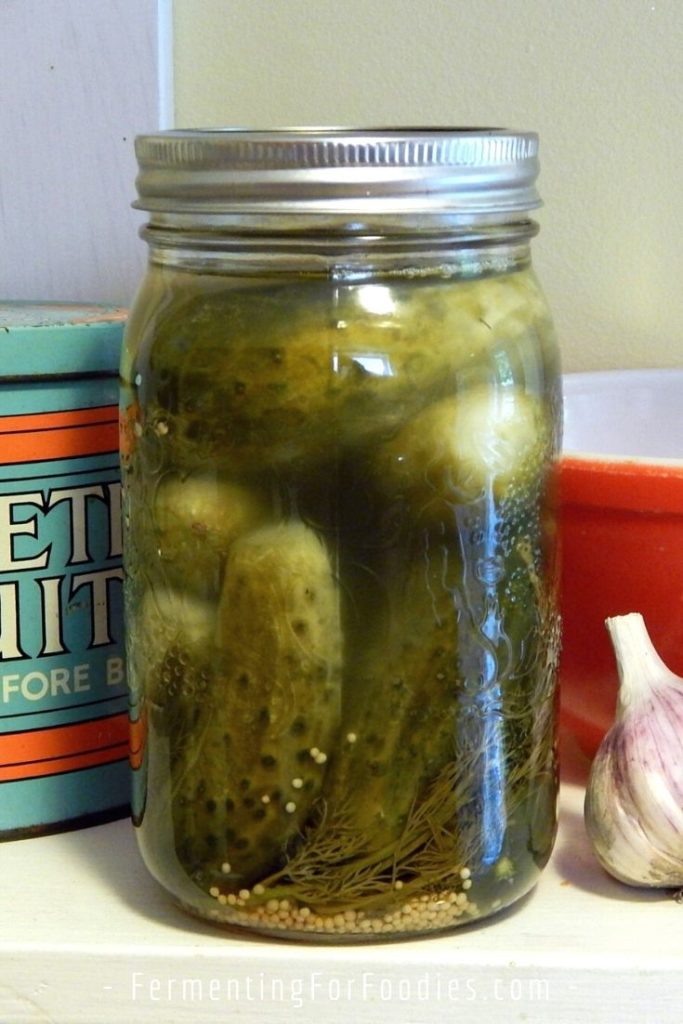
Grandma’s Fermented Dill Pickles
This traditional recipe makes fermented pickles really easy. Just pack them in a jar and leave them in a dark, cool location for up to 6 months! Skip the work of canning and enjoy probiotic pickles all winter long.
- Prep Time: 10 minutes
- Total Time: 10 minutes
- Yield: 2 quart jars 1x
- Category: Pickles
- Method: Fermented
- Cuisine: Polish
- Diet: Gluten Free
Ingredients
Icing
- 2 lbs pickling cucumbers
- 1/3 cup pickling salt
- 4 cups water (chlorine-free)
Pickling Brine
- 2 cups of chlorine-free water
- 1/4 cup vinegar (5% acidity)
- 2 tbsp pickling salt
Packing in each quart jar
- 1 tsp grated horseradish (see notes for alternatives)
- 1 sprig of dill
- 1 tsp mustard seed
Instructions
- Trim the blossom ends off the cucumbers.
- Mix the icing solution using cold water, and let the cucumbers soak in the icing solution overnight (for 8 to 18 hours). Keep the cucumbers submerged in the icing solution by weighing them down with a dinner plate or bags of ice. If it’s really warm in your house, stash them in the fridge for the icing.
- Once you’ve set up the cucumbers for icing, mix the pickling brine ingredients (vinegar, salt, and water), bring them to a boil, and simmer until the salt dissolves.
- Divide the hot brine between two sterilized 1-quart mason jars and allow it to cool overnight.
- The next morning, drain the cucumbers from the icing solution and pack them into the brine-filled mason jars, along with the dill, horseradish, and mustard. Use a weight to keep the pickles below the brine and leave at least 1 inch of headroom at the top of the jar.
- Put a lid on the jar that will allow gas to escape while keeping out mold and other contaminants. (See the section above for different jar and lid options). Store the jar in a cool dark location.
- The pickles will bubble and ferment for 4-5 days, but leave them undisturbed until you are ready to eat them. The flavor is best if they ferment for at least 1 month, however, they will last in a cool, dark location for up to a year.
Notes
- The small amount of vinegar isn’t enough to prevent fermentation. It is just enough to add the acidity needed to ensure a good ferment.
- If you don’t have horseradish you could use a pinch of black tea. It helps prevent the pickles from getting too soft.
- The brine should be enough to cover the pickles if you pack them tightly into the jars. If you can’t fit all the cucumbers in, it’s fine to add a bit more water to ensure everything is below the brine. There’s no need to add more salt or vinegar. The amount included is perfect for 2-quart jars.
- Always be extra cautious with any long-term ferment. See the section above for some tips, including how to sanitize your jars.
- Never eat anything that looks or smells bad. Fermented pickles usually get a dusting of white on them and the bottom of the jar. This is either the spent yeast (from fermenting) or the salt. It is not an issue. If you’re concerned, check out this reference for any pickle problems.
Nutrition
- Serving Size: Approx. 1 pickle
- Calories: 19
- Sugar: 1.9g
- Sodium: Approx. 184mg
- Fat: 0.1g
- Carbohydrates: 4.2g
- Fiber: 0.6g
- Protein: 0.7g
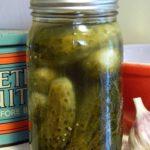
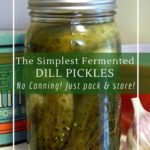
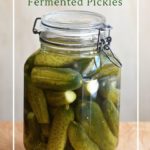
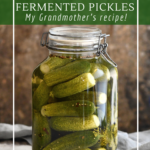
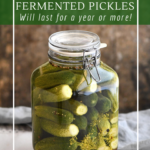
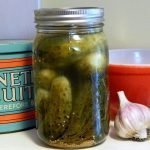
Hi Emillie, I’m curious about your statement to not use garlic. My recipes for fermenting Brussels sprouts, and most of my other ferment recipes call for cloves of garlic. How did you come to this conclusion?
A few reasons: I took this recipe from a 1950’s cookbook, and it called for me to skip the garlic. Also, garlic is low acid and a risk for botulism. I don’t think that’s an issue for sauerkraut, carrots, etc. However, I leave these pickles, unprocessed, in my closet for months… usually around 9 months until we finish them, so the risk of botulism is greater. Saying that I am currently fermenting garlic in honey and plan to leave it for a few months as well.
It’s all about weighing the risks. And as a blogger, I really don’t want to be responsible for a case of accidental poisoning. 🙂
Thanks. I too have wondered about fermenting garlic and peppers. When we lived in Oregon people were always dying from preserved peppers, though the reports never said how they were preserved. I would think safety would be connected to the salt/water ratio just as it is for any pickles. We always hear to be careful of old pickle recipes because they did not call for as much salt as newer ones do. As I read different recipes for ferments, I have noticed a fairly wide range of salt requirements which always makes me wonder why.
I just wrote a long reply and it disappeared!
Sorry. I have to manually approve comments. 🙂
Understandable!
Just put up 2 jars following this recipe. Looking forward to seeing how it goes (I gave it 5 stars already, just for the idea!). I normally ferment pickles just with the salt brine, not vinegar, but the family prefers the taste of the store-bought ones with vinegar, so maybe this will be the perfect compromise? Just wondering, the vinegar doesn’t kill off the probiotic properties of the ferment? And the fermentation happens just overnight with the “icing” of the cucumbers? Or is there fermentation happening in the salt-vinegar-water solution as well?
Also, just to check – I’m assuming the tsp of mustard is mustard powder, rather than prepared mustard?
I really love this recipe. The icing isn’t the fermentation, it’s to keep the pickles crispy. They seem to ferment just fine with the vinegar. There is very little in the recipe, but it does add flavour and changes the pH of the brine which might help with preventing the wrong sorts of bacteria from colonizing. And I meant mustard seed, but powder will work. (just fixed the recipe.) Hope your family likes them!
Thanks for the reply! Shoot, I have mustard seed and that’s what I normally put in pickles, but for some reason this time it didn’t occur to me. I think my family will like the flavour of the vinegar, so I’ll be very excited if it does still ferment. Will keep you posted.
This is an awesome recipe! My question is if you use a fido jar or airlock or pickle-nipple, do you use a regular lid and ring the first 4 or 5 days, and then put on fido lid. I want to keep my pickles longer than a month so I wasn’t clear on it. Thank you!
The first time I made this recipe I did it in a mason jar with a loose jar ring (in photo), which was how the cookbook described making the pickles. I was pretty worried about them and ate them within 3 months. Now I make them in fido jars and leave them till they’re gone (about 6 months). 🙂
Do you use the sealing ring that comes with the fido jar? And can I make them with a fermenting lid and transfer them to a fido jar after a month or so? I’m worried about gas expansion exploding the fido jar.
A high-quality fido jar should be able to handle the build-up of pressure. The gasket is meant to release some CO2 while preventing anything from entering the jar. I usually just start in the fido and let it go until we eat them. Transferring to a fresh jar is a bit risky, just be sure to sanitize the jar first. Enjoy!
Is this recipe for whole cucumbers? Is there anything I should know about fermenting spears? They’re easier for my kids to hold.
I usually do a mix. However, sliced pickles tend to get really soft in the middle, so I only do it for the larger cucumbers. Enjoy!
HI Emillie,
When using the Fido jars, if you clamp the lid closed during fermentation you might have an explosion. What to you recommend for the initial active gas creation (lactofermentation) period?
If you use high-quality fido jars, they are able to withstand the build-up of pressure during fermentation. The gasket will allow some CO2 to escape while preventing contaminiation. I’ve been using mine for years and never needed to burp or release pressure. They really are great for fermenting!
Thanks! You show a really big one (1 or 2 gallon?) at the beginning of the post. Would you feel comfortable using that one with the lid closed?
Yes! I put those pickles up in September, and just opened them about 2 weeks ago. So about 9 months in the closet with no burping, checking or anything. I use the expensive Italian fidos, Bormioli brand. However, other people have had success with other brands too. Cheers!
Can sea salt be subbed for pickling salt?
It’s possible but not ideal. Check the label for additives. The minerals in the sea salt may not be good for pickling and because there is such a range of sea salts (natural product, terroir) YMMV. Better the green-box pickling salt.
I agree with Dave! As long as you use pure non-iodized, sea salt then it will be fine. Enjoy!
Love it! Thanks for sharing.
I am new to this site, but have to do some remembering….. My GMA made the best pickles, from her garden. Used mason jars and garlic, lots of garlic. Did I say I loved her pickles! She made her brine of vinegar, salt and water, hot and boiling, and poured boiling water over the jars and lids, packed the pickles and spices, dill and garlic and a few pepper corns, then poured her hot brine over the cukes and sealed the lid finger tight. She turned the jars over, covered with a towel and let them cool. You listened for little sucking pops. After they cooled they went to the brick house(her version of a cellar(not very cool in Texas). Any that did not seal(have a sucked in lid) were put in the ICE BOX and eaten first. No one got sick. She rotated her jars in the brick house so hopefully we ate the oldest first, but never put dates on her jars, she reused then all the time. Bought new lids when they were rusted.
So my question is, what kind of pickles were these? Fermented? I know the hot brine and covering them with towel was what “cooked” them. I’ve made them before when I had a garden.
It’s amazing how things were done back then and that we survived. No air conditioning in hot humid south Texas. That’s the part I am most surprised about. I am really dependent on AC. I think all that garlic helped with tolerating the heat.
Thanks for sharing your story. Since the pickles were hot packed, it sounds like an easy version of a typical canned pickle. She just skipped the canning part. Canning standards use to be a lot less rigorous. 🙂
You mention in other parts of your website that the quantity of salt is adjustable and we are finding this recipe a bit too salty for our taste. I weighed my jars as you suggested and found that 22.4g of salt is the minimum I need. Would this be spread out between the Icing step and the pickling brine, or is it the total used just in the brine? If it is the amount used for the brine, can I also reduce the Icing salt quantity?
Also, I am using the Fido jars you recommended with the blue lid for the first time, it has been about 24 hours since the first batch was sealed in the brine. Should I already be seeing bubbles? At what point do I know if the fermenting process has started or if it didn’t ‘take’ for some reason?
Thanks!
Hi Heidi,
You can definitely scale down the amount of salt in the brine. I imagine you used my salt calculator for 2.2% salt, so that amount is exactly what you need to ensure a safe ferment. As for the icing, it’s used to help draw water out of the cucumbers so they remain firm while fermenting. You could reduce the salt in the icing, but it probably won’t affect the overall saltiness of the pickle as much as reducing the salt in the brine.
Pickles won’t bubble as much as some other ferments (like sauerkraut). Also, it usually takes 2-3 days before you’ll see some small bubbles and slight cloudiness in the brine. So check them again in a few days.
Enjoy! Emillie
Should I store them in the fridge? Or are they fine left out?
They are fine to be left out in a cool dark location for up to a year. However, once you open the jar and start eating them, I recommend storing them in the fridge. Enjoy!
Could I use Celtic Sea Salt Light Grey Celtic Coarse for pickling? It does say pickling on the bag.
Yes! Any non-iodized salt is fine. Enjoy!
First time seeing the term “icing” in a pickle recipe.
Really? It’s recommended in a few of my pickling cookbooks. It helps draw out the water for firmer pickles. Enjoy!
Just ordered my pickling cucumbers to make this recipe – so excited!
I made your recipe for fermented horseradish a couple days ago. Would it be alright to use that instead of the fresh grated horseradish in the recipe?
Using the homemade fermented horseradish will definitely work for these pickles. Enjoy!
I like the idea of the little bit of vinegar to protect the ferment. Some old recipes call for higher than “normal” percentages of salt than other ferments.
Perhaps some pickled garlic added will help the flavour.
I calculated the weights of cucumbers and water and found that the salt percentage by weight to be about 2.5%
and with the little vinegar I’m happy with that, so this recipe is a keeper – and will try soon with gallon bottles.
Thanks.
Great! I have honestly used this as my go-to pickle recipe for at least 6 years. And I’ve never had a failure!
Hi, I had bought several 2 quart jars with plastic lids. Can I use them for this recipe? Did I do a bad thing and waste my money?
Hum… I’m not sure. I’ve used mason jars with snap lids (that allow bubbles to escape but are otherwise sealed). If you have a weight, then as long as your pickles are kept under the brine they will be safe to eat. But it’s hard to say what the lids will be like, without seeing them in person. Good luck!
I put my pickles into a large crock. I used the weight and then covered the top with some cheese cloth and then the heavy lid to hopefully deter the fruit flies. It’s very warm here this summer. When should I check them for being “eatable”? And can I just leave them in the crock or should I put them in jars in the fridge when they’re done fermenting?
Hi Dawn, You can definitely leave the pickles in the crock for as long as you want. That’s truly the traditional way! However, make sure the cukes stay below the brine. There is a risk of mold on top of an open crock. However, it’s not an issue… you can simply scrape it off the top and the pickles will be untouched by mold. (It can’t live in the salty brine). However, you can put them in jars in the fridge if you want. That will definitely decrease the risk of mold.
You can start eating the pickles after 5 days… they are ready as soon as you enjoy the flavor. However, they will continue to ferment and change flavor the longer you leave them. So if they’re not sour enough, just let them keep fermenting! They’re typically considered done fermenting after 4 to 6 weeks.
Cheers, Emillie
Thanks so much for the speedy reply. Also, I didn’t use pickling salt as its hard to find a good quality one here in Canada. I used my Andean salt that has no additives. I used 3/4’s of what you called for as it’s a finer salt than pickling. I know there’s a better way to judge that but I just eyeballed it. Hopefully not going to give me problems… 😛
Hi, Any non-iodized salt will work (I often use pink Himalayan salt). Fine salt is definitely less bulky than flakey pickling salt. Luckily, ferments can range between 2% and 5% salt, so you’re probably fine! Hope it works out for you.
I heard somewhere about adding bay leaf for tannin in fermenting pickles. Is this true?
Bay provides both flavor and tannins to pickles. Personally, I usually use black tea. However, you can add 3-4 bay leaves per quart jar instead. Cheers!
This is great! Can’t wait to try it. Question – is there a formula for doubling, tripling, or 4x-ing the recipe? There are lots of cucumbers in my garden, and I want to pickle as many as possible, but I’m not sure how the solutions would change. Thank you!
I just chopped rather than grated the horseradish. Do you think that will be a problem? I could open the jar and try again, as I just did it today. Also, the brine wasn’t nearly enough for 2 quart jars, to cover the pickles, so I added some of the icing solution to cover them. Do you think that will be an issue? I didn’t want to start all over with the brine b/c it takes a while to cool and the pickles had already been in the icing solution over night.
Hi Jessica,
Chopping the horseradish is perfectly fine. It is hard to judge the exact amount of brine because it depends on the size of the cucumbers. It’s easier to pack the small cucumbers in tightly. 🙂 I’ve never tried adding the icing water instead. I usually just leave out a few cucumbers. However, the icing solution is definitely salty enough to ensure a good ferment. So I think it will be fine. I wouldn’t open the jars at this point.
I have had the toughest time finding pickling cucumbers this year. I’ve looked everywhere! Do you mind sharing where you got yours from? I’m dying to pack up a batch of pickles.
Thanks, Emillie
Thanks, Emillie, fingers crossed that the brine will work. I got the cukes at Dan’s farm on Oldfield road. They looked good, but I never know until I’ve opened the pickles whether the cukes were fresh enough to stay crunchy–that’s my most frequent problem with fermented pickles, is that they’re soft.
Thanks! I’ll head out there this weekend. I know what you mean. The ones I got last year were too large and seedy. They just went mushy in the middle.
I once used grape leaves in my canned dill pickles, they were the best I have ever made. I want to ferment my pickles this year. What do you think about my adding a grapevine leaf?
Absolutely! I usually use a pinch of black tea for my tannin, but grape leaves will work too! They don’t stop fermentation. They just provided the tannins necessary to keep the pickles crunchy. Enjoy!
The pickling brine is not enough liquid for even one quart jar. Am I missing something?
Hello, I just put up a double batch of these pickles this weekend! The liquid should be enough for 2 quarts, however, you really need to pack the cucumbers in. You want them to be packed in tight enough that they won’t float. That can be tricky with curved cucumbers. In that case, simply fill the jars with as many cucumbers as possible. Divide the brine between the two-quart jars. Then top with a bit more filtered water. The salt is enough for 2 quart-sized jars, so adding more salt or vinegar is unnecessary. The extra water is simply replacing the water from the cucumbers.
I’ll look at the recipe today, and see if I can make it a bit clearer. Cheers, Emillie
Hi, if I do not have horseradish, can I put a grape leaf in the bottom of each jar? And if I do that, do I leave the grape leaf in the jars while the cucumbers are fermenting? Also, once the jars are open. Do I remove the grape leaves or do I leave it in. Thanks so much.
Grape leaves are a great source of tannin. I often use a pinch of black tea instead. Place it in for the ferment, and leave it there until you finish eating the pickles. It’s always best not to open a jar until you’re ready to eat them. 🙂 Enjoy!
Hi , I have a few large cucumbers that I would love to try sliced into spears with your grandmothers recipe. Do I ice them whole or sliced ?